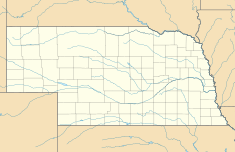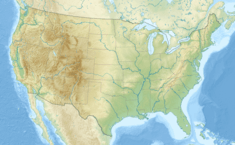Spencer Dam facts for kids
Quick facts for kids Spencer Dam |
|
|---|---|

Spencer Dam in 2010
|
|
|
Location of Spencer Dam in Nebraska
|
|
| Country | United States |
| Location | Near Spencer, Nebraska |
| Coordinates | 42°48′32″N 98°39′23″W / 42.8090°N 98.6564°W |
| Purpose | Hydroelectric |
| Status | Failed |
| Opening date | 1927 |
| Demolition date | March 14, 2019 |
| Owner(s) | NPPD |
| Dam and spillways | |
| Type of dam | Buttressed concrete gravity and embankment |
| Impounds | Niobrara River |
| Height (foundation) | 26 ft (7.9 m) |
| Length | 3,698 ft (1,127 m) |
| Reservoir | |
| Total capacity | 16,847 acre⋅ft (20,780,000 m3) (silted) |
| Surface area | 1,200 acres (490 ha) |
| Power station | |
| Name | Power station |
| Commission date | 1927 |
| Decommission date | 2017 |
| Type | Conventional |
| Turbines | 1x 2000 KW 1x 1300 KW |
| Installed capacity | 3300 KW |
| Annual generation | 14,848,000 KWh |
The Spencer Dam was a special kind of hydroelectric dam on the Niobrara River in Nebraska, USA. It was near the town of Spencer. This dam used the natural flow of the river to create electricity.
The Nebraska Public Power District (NPPD) operated the dam. Sadly, in March 2019, a huge storm brought heavy rain and melting snow. This caused the dam to break, leading to a lot of flooding downstream.
Contents
Building and Rebuilding the Dam
The Spencer Dam was first built in 1927. It was located about 39 miles (63 km) upstream from where the Niobrara River joins the Missouri River. The dam was very long, about 3,698 feet (1,127 m), and stood 26 feet (7.9 m) high. It was made of different parts.
The dam had a power station on the north side of the river. This station used two large machines called generators to make electricity. These generators could produce 2,000 and 1,300 kilowatts of power. The dam also had special gates that could open to let water through.
In 1935, part of the dam broke because of a large ice jam in the river. But it was rebuilt and made strong again by 1940.
Dealing with Sediment
After it was built and rebuilt, the dam's reservoir (the lake behind it) quickly filled up with sand and mud. This is called sediment. Even though this didn't stop the dam from making power, workers had to clear the sediment twice a year.
Since 1948, the dam's gates were opened for about two weeks each year. This allowed the river to flow freely and wash the built-up sediment downstream. Sometimes, this process caused problems for fish in the Niobrara River. To fix this, engineers learned to drain the reservoir more slowly. This helped protect the fish.
The Dam's Role and Future Plans
By 1985, Spencer Dam was the only working hydroelectric power plant on the Niobrara River. The NPPD had rights to use a lot of water from the river to make electricity.
In 2015, the NPPD announced that they would stop using the Spencer power plant by 2017. It was becoming too expensive to make electricity there. The plan was to sell the water rights to the Nebraska Game and Parks Commission and other local groups. These groups wanted to manage the river for farming, fun activities, and protecting wildlife. The dam itself was supposed to stay in place, but with its gates removed so the river could flow freely.
The Dam's Failure in 2019
On March 14, 2019, the Spencer Dam broke. A huge storm had caused heavy rain, melting snow, and large chunks of ice to crash into the dam. The part of the dam made of earth was washed away in two places. A massive wall of water, about 11 feet (3.4 m) high, rushed downstream.
Impact of the Flood
The flood caused a lot of damage. A building and a home below the dam were destroyed. Part of a major road, U.S. Highway 281, was also washed out. In the town of Niobrara, many buildings and a bridge were swept away. A water pipe under the river was also destroyed, leaving about 2,000 people without water. People living in low areas along the river had to leave their homes for safety.
The local sheriff quickly told everyone along the Niobrara River to evacuate. He asked people to spread the word to help keep everyone safe.
Aftermath and Causes
As the floodwaters from the Niobrara River reached the Missouri River, more water had to be released from another dam called Gavins Point Dam. This was done to manage the huge amount of water.
Later, the NPPD explained that workers had tried to open the dam's gates to let water out. But some gates were frozen shut because of the cold weather. This might have caused water to go over the top of the dam's earth sections. Also, very large ice chunks, as big as trucks, hit the dam and destroyed bridges downstream.
An inspection in April 2018 had already warned that the dam had problems. These problems could lead to the dam breaking during very strong storms.
Because the dam broke before it could be sold, the original plan to sell it to the state of Nebraska changed. The remains of the dam are now planned to be removed.



